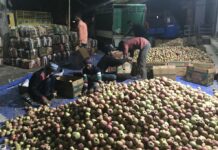The lack of a female buddy in cricket can land a batsman in trouble! Well, you can’t score centuries. At least, not at the international level. Abdul Mohamin reports.
Cricket is gentleman’s game, but the gentleman cannot have this game without a much needed female counterpart, a quality international bat sourced from female willow trees.
In a gender war among willows to make best cricket bats, English rule with their female variety while the Kashmir willow bats are runners up in this match as here the willow trees are predominantly male.
Dr Nazir Ahmad Masoodi, Dean Faculty of Forestry, SK University of Agricultural Sciences and Technology (SKUAST) says that the willow used to produce international standard bats is female type, Salix alba var caerulea, and in England the willow is purposely grown for manufacturing cricket bats.
English willow is considered as tough, shock-resistant, lightweight and does not splinter easily – requisites for making a cricket bat. Britain also exports clefts – raw sawn willow for making bats, to other countries particularly to Pakistan’s Sailkote based sports goods industry for manufacture of bats.
Experts say Kashmir posses same genus and species willow but most of the trees are male, an outcome of vegetative propagation.
Branded as Kashmir willow, it is highly prized and is a stiff competitor to English willow. To give Kashmir bat industry a competitive edge in international market? scientists at SKUAST say, the male supremacy in the raw material has to end.
 Experts attribute the absence of effort to grow willow for commercial purposes to smuggling of willow clefts to outside bat manufactures at throwaway prices robbing both growers and bat manufacturers of attractive returns.
Experts attribute the absence of effort to grow willow for commercial purposes to smuggling of willow clefts to outside bat manufactures at throwaway prices robbing both growers and bat manufacturers of attractive returns.
Masoodi says that female of willow tree also grows in Kashmir, which can be identified only during flowering process. The faculty at the University has identified these female willow trees at four different locations in the valley.
They are looking at possibilities of large scale propagation of female willow with government support, particularly around wetlands which are suitable sites for these trees.
Masoodi says it is “imperative” to propagate willow on scientifically recommended types fearing a raw material crunch in bat industry in near future.
Experts say that 13 million bats of international standard are required every year and advise massive propagation of willow trees to harness the potential of this industry, which produces more than 15 lakh quality Kashmir willow bats annually.
The bat manufactures here too are concerned about the depleting willow reserves, as there has been an increasing trend to grow poplar trees here.
Abdul Qayoom Paray, manufacturer of Marshal brand cricket bats at Chersoo Islamabad, hub of bat industry in Kashmir, says, growers are more interested in growing poplar trees, that not only grow fast, but fetch good price as timber and a much needed raw material in plywood industry.
It takes 20 years for a willow tree to attain a girth of 36 inches and a height of 10 feet, which is required for its use in bat manufacturing, while fast growing poplars are ready to be sold only after seven years.
Paray believes that depleting willow trees base will hit the cricket bat industry in near future. “We will have to utilize the scientific knowhow on both raw material and manufacture process to save this industry,” he said.
However, experts at SKUAST say willow trees can grow fast under scientifically recommended techniques.
A bat of international standards can fetch from Rs 12,000 to 50,000. Kashmir willow bats cannot attract such prices as it has a reddish lusture, presence of lower grains structure and less resilience. Kashmir willow bats are considered fit for club level cricket, even though some players do use them at higher levels also.
The bat manufacturers say that a decade ago, the hope for revival was linked to the ban on export of clefts outside the state, however, bat manufacturers in Punjab and Utter Pradesh in collaboration with locals are smuggling clefts at a much faster rate to meet an expected surge with the ongoing Cricket World Cup.
The export of willow as raw-material or semi-finished products outside the state is banned under JK State Forest Act. People associated with the trade say that millions of clefts priced less than Rs 200 per cleft reach bat manufacturers outside the state every month, who make a lot of profits by churning out bats out of these clefts.
Some north Indian states are keen to grow cricket bat willow, while Australia has already made good progress in its propagation, now branded as ‘Australian English Willow’.
The cricket bat market is around Rs 100 crore in India only. Experts say a change in willow gender is vital for survival and better returns of Kashmir’s bat industry.















